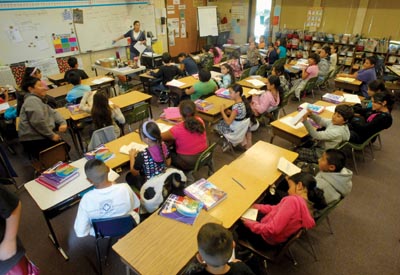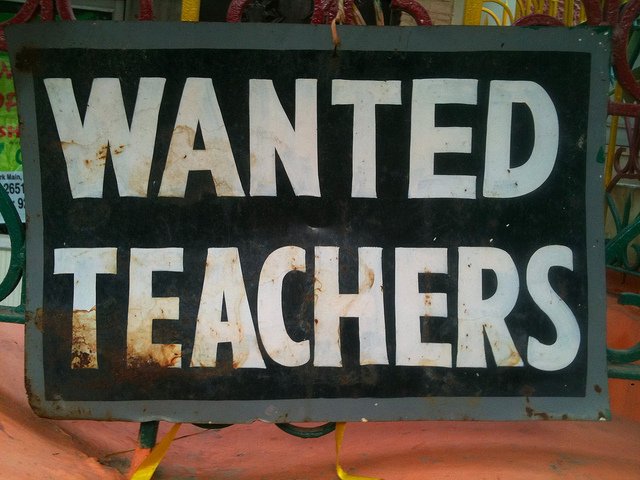
image via npr.org
A few months ago, I wrote about the dangerous levels of depression and anxiety teachers reported during the 2021/22 school year and the disturbingly high percentage of teachers who said they would likely leave the profession earlier than they originally intended.
Now the start of a new school year is upon us and districts across the U.S. are scrambling to find teachers to fill classrooms. Here are a few examples as of July 18, 2022:
- Metro Nashville Public Schools (TN): 932 licensed teaching positions open, 186 paraprofessional positions open.
- Los Angeles Unified School District (CA): 1037 teaching and paraprofessional positions open. California was already experiencing a teacher shortage before the pandemic and currently has 13,000 teachers working with substandard credentialing, as well as a large number of teachers working on provisional staffing permits. Estimates on the shortage statewide hover around 10%.
- Omaha Public Schools (NE): 594 open teaching positions and the district anticipates they will be 230 positions short when the school year begins.
- Florida is short 9000 teachers statewide for the upcoming year.
- The 3 largest districts in Texas (Dallas ISD, Houston ISD, and Cypress-Fairbanks ISD) have 2846 open teaching positions between them.
And, as of August 2:
- Clark County Schools (NV), which serves Las Vegas and its environs, is reporting a 10% shortage of teachers in most of its schools — about 1800 teachers across the district.
- Wake County School District (NC) has 744 certified teaching positions open and 460 certified and non-certified instructional support positions open, 24 days before school starts.
- Kansas is reporting a shortage of 1400 teaching positions statewide, about 4% of all teaching positions. This appears to be just teachers – not paraprofessionals or non-certificated instructional help.
Obviously, not every district or even every state is experiencing this shortage to the same degree, but nationally, the Wall Street Journal reported that about 300,000 public school teachers and other workers left the field between February 2020 and May 2022. Why this is happening is no secret. Chronically low pay, punitive school boards and state legislatures that have explicitly targeted teachers, and parents who belittle, attack, and even propose bounties to report teachers who step over new and impossibly intricate limitations on content. All this in a pandemic where things shifted daily, and nothing worked very well, and everyone was angry and demoralized all the time.

image via sanbenito.com
A lack of teachers in classrooms creates a profound ripple effect. At the most immediate level, classroom sizes increase, which puts more demands on the teachers who are there. Without enough paraprofessionals it becomes difficult to give students the individual attention and practice they need and without enough non-certified personnel, still more demands fall on the classroom teacher – lunch duty, bus duty, recess duty. A shortage of teachers can also lead to more drastic measures. In Minnesota, a number of rural districts are facing potential consolidation – the combining (often by force) of two or more districts to maximize resources and available educators. That often means busing kids to schools in other towns, something that can take up to an hour or more. Long bus rides mean earlier mornings to get everyone there on time. Earlier mornings can mean sleepy kids, or kids who didn’t eat, with all the focus and behavior issues that accompany that. And all of it makes the teacher’s job more stressful. Increased stress spurs more resignations; Texas alone saw more than 400 cases of contract abandonment last year – teachers walking away from their jobs in the middle of the school year. One district in Kansas, Olathe, saw 44 cases last year; prior to the pandemic, 5 cases would have been disturbingly high. And make no mistake, contract abandonment is a serious issue: when teachers leave in the middle of the year, learning loss for their students can range from 32 to 72 instructional days. That’s just about as bad as a feedback loop can get.
At the same time there is unprecedented pressure from school choice advocates to allow a privileged few to take their tax money elsewhere for private education, citing the dismal records of public schools – a situation that has sometimes been materially facilitated by the choice advocates themselves by denying funding and creating legislation hostile to teachers and impossible to adhere to.
That colleges and universities are not graduating enough new teachers to meet the demand is openly acknowledged. The Economic Policy Institute (EPI) projects that by 2024 there will be a supply of just over 100,000 teaching-program graduates to fill a projected demand for approximately 300,000 new teachers nationwide. I’m not even sure those numbers fully capture the scale of the problem. New York alone estimates it will need 180,000 new teachers over the next decade, but enrollment in teaching programs in the state has fallen by 49%.

image via progressive.org
States are trying a variety of measures to attract new teachers and retain current ones. The Des Moines Public Schools (IA) offered a $50,000 retirement bonus paid over two years for teachers who agreed to stay for at least that long. Fifty-eight teachers signed on to the program, but the district is still 95 teachers short with 3 weeks until school starts. Other states are lowering requirements for teaching just to get bodies in classrooms. New York lowered the number of classroom teaching hours for prospective teachers from 100 to 50 and now allows teachers to be “K-12 literate,” meaning that once certified, they can teach any grade level they want (while this may work for adjacent grade levels, like a 7th grade teacher teaching 6th, it’s not going to work well if a kindergarten teacher is suddenly thrust into a high school biology classroom or vise versa). Missouri is waiving a passing grade on its pre-teaching assessment as long as the student maintained a 3.0 in their coursework and student teaching. New Jersey is piloting a 5-year program whereby it will waive either the minimum GPA requirement or the minimum test score requirement and certify new teachers on a limited basis; and Arizona has waived the requirement for a bachelor’s degree entirely; students can begin teaching in classrooms (supervised), while they simultaneously work toward a bachelor’s. This one blows my mind because getting a bachelor’s isn’t easy but it’s a leisurely cakewalk compared to that first year of teaching, even fully certified. I can’t see how doing both will work – one or both sides of this equation are going to get shorted. Also, it assumes a lot of stuff is in place to help new teachers, which is a big (and often wrong) assumption. And let’s remember, a teacher can only take a student as far as they themselves have gone; staffing classrooms with less-educated people doesn’t seem like a winning strategy.

image via EdWeek
Just to be sure this wasn’t my bias toward traditional programs speaking, I dug into the research on alternatively certified teachers. These programs do get more diverse teachers into classrooms which is critically important and a positive benefit, but a major (and, as far as I can tell, ignored) problem is that those who become teachers by this means are much more likely to leave teaching than their traditional peers. A 2016 study from Vanderbilt University found that alternatively certified teachers have an attrition rate almost 8 percentage points higher than that of graduates of a standard university-based teaching program—25% vs. 17%. The biggest issue here was that teachers didn’t feel supported to do their jobs in the classroom and that lack of support led them to leave. So while those alternatively certified (AC) may be perfectly good, even gifted, teachers, the high attrition rate led the author of the study to conclude that “the AC pipeline may be more of a stop gap, than a long-term solution.”
While I understand the desperate need to get adults into classrooms and acknowledge that such measures are necessary for the very short term, I would contend that none of them addresses the most critical issues surrounding teaching and none offers a long-term solution. Relying on alternative certification is like treating a shattered femur with a band-aid. The bigger, underlying problems (lack of teacher respect and support, poor pay, inadequate funding for basic materials and equipment, hostile legislation) still remain, festering away. We can’t deploy band-aids and half measures anymore; we wouldn’t ask an orthopedic surgeon to fix that shattered femur in a dark OR with no monitoring equipment, or ask them to prep the patient, administer the anesthesia, monitor the EKG, bring their own cotton, gauze and scalpels, and wash the scrubs afterward. Or — God forbid — replace them with someone studying to be a surgeon and cross our fingers that we’re ok with the result. To succeed, they need fully stocked ORs, trained support staff to assist them in doing the best job possible, and a basic recognition of and trust in their abilities; all this gives them the freedom to use their skills in the best possible ways and do what their training has prepared them to do.
It’s likely too late for those who have left or are leaving the profession, but we can do better – we have to demand better — moving forward.
